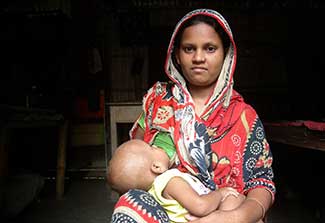Research findings prevent HIV transmission by nursing
May / June 2021 | Volume 20 Number 3
 Image Photo by Tareq SalahuddinWomen face many barriers to exclusive breastfeeding in low- and middle-income countries.
Image Photo by Tareq SalahuddinWomen face many barriers to exclusive breastfeeding in low- and middle-income countries.
By Susan Scutti
In the days when HIV/AIDS was a death sentence, a recommendation against breastfeeding might have seemed the simplest way to prevent disease transmission to newborns. But scientists understood that would pose other risks. “We knew from the 1960s that early weaning often causes death in low-resource settings where risks of diarrheal and infectious diseases are high, and safe breast milk alternatives may not be available,” said Dr. Grace Aldrovandi, UCLA scientist and a lead investigator in an international clinical trials network. “The WHO came out with the recommendation that HIV-infected women should exclusively breastfeed for four months and then abruptly wean.”
The feasibility of this approach was tested by weighing the dangers of early weaning against the risks of HIV in a study in Zambia. “Much to our surprise, at the end of two years, the same number of children in the abrupt weaning group died of infectious diseases as those that we let breastfeed longer who got HIV,” said Aldrovandi. These results “surprised the field,” yet, in time, “with the introduction of effective ART in sub-Saharan Africa, the calculus totally changed.”
To minimize risks of mother-to-child HIV transmission, scientists examined possible prevention strategies through the Promoting Maternal and Infant Survival Everywhere (PROMISE) study. Funded by the NIH’s National Institute of Allergy and Infectious Diseases, PROMISE identified the most advantageous antiretroviral (ART) drug regimen for reducing viral transmission during pregnancy and breastfeeding. “PROMISE under- scored the importance of maternal viral suppression and getting optimal ART,” said Aldrovandi.
Before ART became widely available in Africa, scientists explored various solutions to the problem of maternal-child HIV transmission through breastfeeding. For example, PATH scientist Dr. Kiersten Israel-Ballard created a simple process so that a mother with HIV could flash-heat her own breast milk in her own home. A feasibility trial in Tanzania, funded by the NIH’s National Institute of Child Health and Human Development, proved none of the samples contained bacterial pathogens and “also showed that if you gave mothers this option, many would use it,” said Israel-Ballard.
Breastfeeding is still a critical issue in LMICs, where a significant number of babies remain at risk of HIV. “If you’re a baby gestating in the womb of a woman with HIV who isn’t taking antiretrovirals, you have three bullets to dodge,” explained Aldrovandi. HIV can be transmitted from mom to baby in utero (about 10-15% of cases), during vaginal birth (about 20-30%) or through breast milk (depending on duration, ranges between 5% and 25%). “At no point in this cascade is it 100%,” said Aldrovandi.
While ART lowers the amount of virus in a mother’s blood and decreases the amount transferred through breast milk, drug adherence is often less than perfect. “As we all know it is difficult to adhere to the meds. Breastfeeding lasts for a couple of years and that’s a long time for a mother to remain suppressed, given that her HIV infection is probably number 20 on her list of things she’s dealing with, such as taking care of other children, earning money and dealing with food insecurity,” said Aldrovandi.
“What we are hoping for is longer lasting ART modalities to keep the mother suppressed and decrease baby’s chances of becoming infected.” In the meantime, Aldrovandi continues to puzzle over why some babies get HIV through breast milk and others don’t.
“I did a study measuring HIV RNA in breast milk and the mammary epithelium is amazingly effective at keeping out virus. A woman can have a million copies in her blood but very little to none of it gets across,” said Aldrovandi. Yet, she had seen in the years before ART that babies infected in utero did a lot worse than babies infected via breast milk. Aldrovandi and many of her peers are trying to better understand the relationship between maternal microbes and infant microbes, and how that ultimately affects infant health.
More Information
-
Promoting Maternal and Infant Survival Everywhere (PROMISE) study results
-
International Maternal, Pediatric, Adolescent AIDS Clinical Trials (IMPAACT) Network
-
Effects of early, abrupt weaning on HIV-free survival of children in Zambia
New England Journal of Medicine, July 10, 2008 - Grant:
Pathogenesis of mother to child transmission of HIV via NIH RePORTER
- Grant:
Short exclusive breastfeeding to reduce postnatal transmission of
HIV via NIH RePORTER
- Grant:
Effect of feeding buddies on adherence to WHO PMTCT guidelines in South Africa via NIH RePORTER
-
Feasibility of using flash-heated breastmilk as an infant feeding option for HIV-exposed, uninfected infants after 6 months of age in urban Tanzania
JAIDS Journal of Acquired Immune Deficiency Syndromes, May 1, 2012 -
Human milk oligosaccharide concentration and risk of postnatal transmission of HIV through breastfeeding
American Journal of Clinical Nutrition, October 2012 -
Association between breast milk bacterial communities and establishment and development of the infant gut microbiome
JAMA Pediatrics, July 1, 2017 -
Shared and distinct features of human milk and infant stool viromes
Frontiers in Microbiology, June 1, 2018 -
No evidence of infectious SARS-CoV-2 in human milk: Analysis of a cohort of 110 lactating women
medRxiv, April 7, 2021
To view Adobe PDF files,
download current, free accessible plug-ins from Adobe's website.
Related Global Health Research Topics